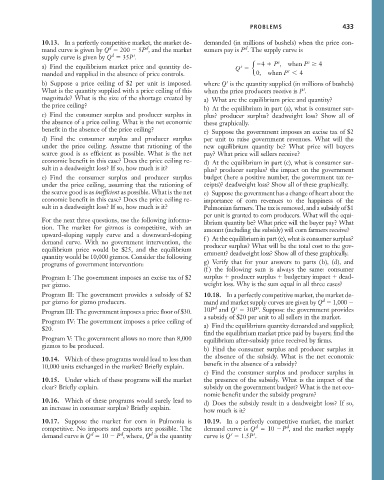Page 459 - Microeconomics, Fourth Edition
P. 459
c10competitive markets applications.qxd 7/15/10 4:58 PM Page 433
PROBLEMS 433
10.13. In a perfectly competitive market, the market de- demanded (in millions of bushels) when the price con-
d
d
d
mand curve is given by Q 200 5P , and the market sumers pay is P . The supply curve is
s
d
supply curve is given by Q 35P . s s
a) Find the equilibrium market price and quantity de- Q e 4 P , when P 4
s
s
manded and supplied in the absence of price controls. 0, when P 6 4
s
b) Suppose a price ceiling of $2 per unit is imposed. where Q is the quantity supplied (in millions of bushels)
s
What is the quantity supplied with a price ceiling of this when the price producers receive is P .
magnitude? What is the size of the shortage created by a) What are the equilibrium price and quantity?
the price ceiling?
b) At the equilibrium in part (a), what is consumer sur-
c) Find the consumer surplus and producer surplus in plus? producer surplus? deadweight loss? Show all of
the absence of a price ceiling. What is the net economic these graphically.
benefit in the absence of the price ceiling? c) Suppose the government imposes an excise tax of $2
d) Find the consumer surplus and producer surplus per unit to raise government revenues. What will the
under the price ceiling. Assume that rationing of the new equilibrium quantity be? What price will buyers
scarce good is as efficient as possible. What is the net pay? What price will sellers receive?
economic benefit in this case? Does the price ceiling re- d) At the equilibrium in part (c), what is consumer sur-
sult in a deadweight loss? If so, how much is it? plus? producer surplus? the impact on the government
e) Find the consumer surplus and producer surplus budget (here a positive number, the government tax re-
under the price ceiling, assuming that the rationing of ceipts)? deadweight loss? Show all of these graphically.
the scarce good is as inefficient as possible. What is the net e) Suppose the government has a change of heart about the
economic benefit in this case? Does the price ceiling re- importance of corn revenues to the happiness of the
sult in a deadweight loss? If so, how much is it? Pulmonian farmers. The tax is removed, and a subsidy of $1
per unit is granted to corn producers. What will the equi-
For the next three questions, use the following informa- librium quantity be? What price will the buyer pay? What
tion. The market for gizmos is competitive, with an amount (including the subsidy) will corn farmers receive?
upward-sloping supply curve and a downward-sloping
demand curve. With no government intervention, the f ) At the equilibrium in part (e), what is consumer surplus?
equilibrium price would be $25, and the equilibrium producer surplus? What will be the total cost to the gov-
quantity would be 10,000 gizmos. Consider the following ernment? deadweight loss? Show all of these graphically.
programs of government intervention: g) Verify that for your answers to parts (b), (d), and
(f ) the following sum is always the same: consumer
Program I: The government imposes an excise tax of $2 surplus producer surplus budgetary impact dead-
per gizmo. weight loss. Why is the sum equal in all three cases?
Program II: The government provides a subsidy of $2 10.18. In a perfectly competitive market, the market de-
d
per gizmo for gizmo producers. mand and market supply curves are given by Q 1,000
s
d
s
Program III: The government imposes a price floor of $30. 10P and Q 30P . Suppose the government provides
a subsidy of $20 per unit to all sellers in the market.
Program IV: The government imposes a price ceiling of
$20. a) Find the equilibrium quantity demanded and supplied;
find the equilibrium market price paid by buyers; find the
Program V: The government allows no more than 8,000 equilibrium after-subsidy price received by firms.
gizmos to be produced.
b) Find the consumer surplus and producer surplus in
the absence of the subsidy. What is the net economic
10.14. Which of these programs would lead to less than
10,000 units exchanged in the market? Briefly explain. benefit in the absence of a subsidy?
c) Find the consumer surplus and producer surplus in
10.15. Under which of these programs will the market the presence of the subsidy. What is the impact of the
clear? Briefly explain. subsidy on the government budget? What is the net eco-
nomic benefit under the subsidy program?
10.16. Which of these programs would surely lead to d) Does the subsidy result in a deadweight loss? If so,
an increase in consumer surplus? Briefly explain. how much is it?
10.17. Suppose the market for corn in Pulmonia is 10.19. In a perfectly competitive market, the market
d
d
competitive. No imports and exports are possible. The demand curve is Q 10 P , and the market supply
s
d
d
s
d
demand curve is Q 10 P , where, Q is the quantity curve is Q 1.5P .

